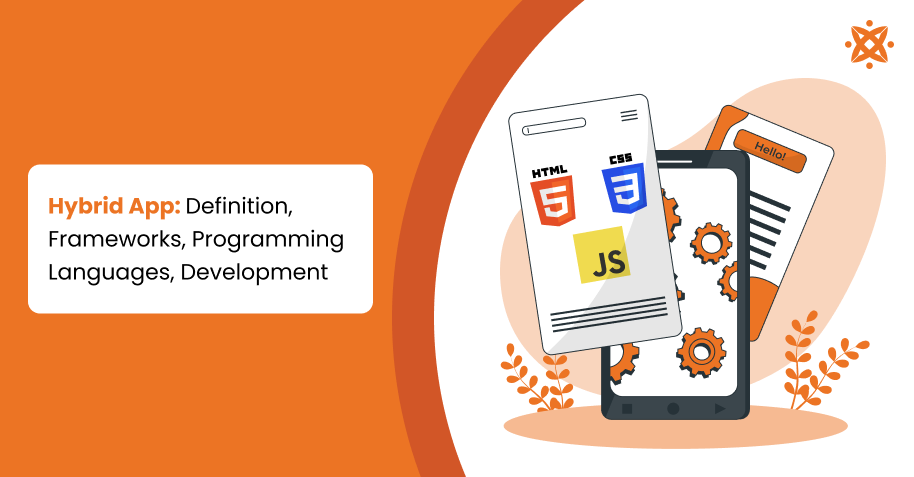
A hybrid app runs on both Android and iOS using a single codebase. They function like native ones but are built using web technologies, making them ideal for businesses aiming to launch quickly and reach broader audiences without managing separate platforms. In real-world use, hybrid apps power e-commerce stores, booking systems, social platforms, and productivity tools that need consistent performance across devices.
The best frameworks and tools for hybrid app development are Ionic, Flutter, Cordova, Capacitor, Node.js, Laravel, Spring Boot, Meteor, Flutter with Supabase, MERN Stack, Tailwind CSS, Bootstrap, Material UI, Ionic UI Components, MongoDB, and PostgreSQL. These frameworks handle both the frontend and backend, allowing developers to create robust, scalable mobile solutions with intuitive interfaces.
The programming languages used in hybrid app development are HTML, CSS, JavaScript, TypeScript, Python, PHP, Ruby, and Java, enabling developers to write flexible, maintainable code across the stack. These languages support everything from UI creation to server logic and third-party integrations.
To develop a hybrid app, the steps are planning the app structure, choosing the right tech stack, setting up the development environment, designing the user interface, developing the frontend and backend, integrating APIs and plugins, testing across platforms, and deploying to app stores. This process ensures that the app is functional, accessible, and ready for real-world usage across both Android and iOS.
According to a report by TechRev (2023), 90% of companies now opt for hybrid app development, resulting in 25-40% cost savings compared to building separate native apps.
What Is A Hybrid App?
A hybrid app is a type of mobile application that combines elements of both native and web applications. It is built using standard web technologies, such as HTML, CSS, and JavaScript, and then wrapped within a native container that enables it to run on multiple platforms, including Android and iOS, using a single codebase. This setup enables access to device features through plugins, giving the app a native-like experience.
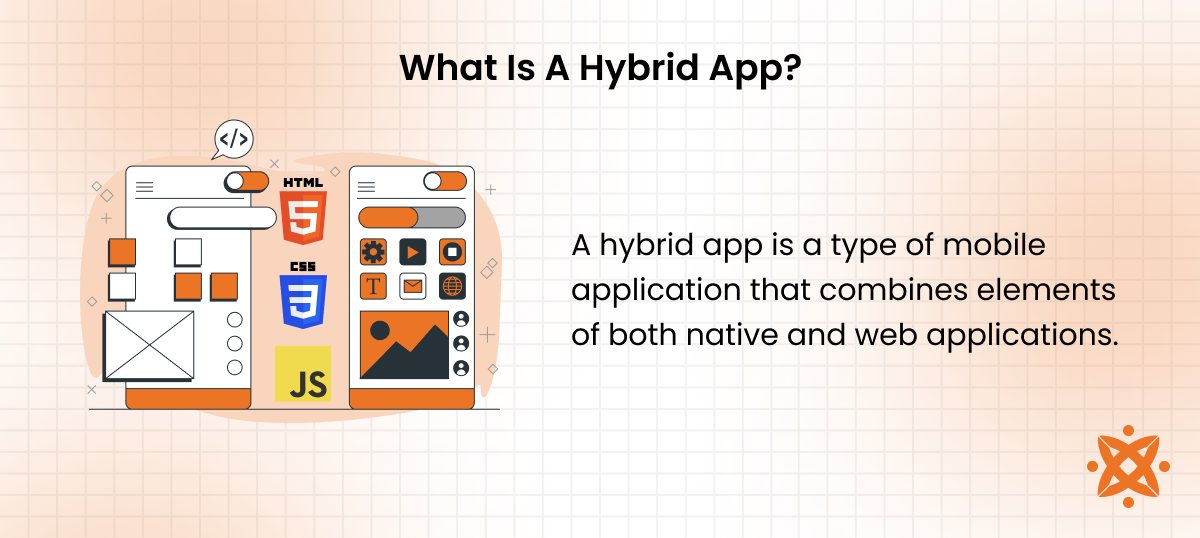
Hybrid apps are widely used for enterprise tools, e-commerce platforms, social media services, and content-driven applications. These apps are suitable for businesses seeking **faster time to market and cross-platform reach without investing in two separate native apps.
The hybrid app architecture involves three layers: the web layer (built using web technologies), the native shell (which includes WebView to render the content), and a bridge layer that allows communication between web code and native device APIs. This architecture supports efficient updates and shared logic while still tapping into native capabilities.
Popular examples of hybrid apps include Instagram, Uber, Evernote, and Gmail. These applications demonstrate how hybrid development supports scalability, maintains performance, and delivers consistent user experiences across platforms.
How Does A Hybrid App Work?
A hybrid app works by embedding web content within a native application shell. Developers write the core of the app using HTML, CSS, and JavaScript, then use a native wrapper, enabled by tools like Cordova or Capacitor, to package the code for deployment across different platforms.
The core mechanism behind hybrid apps is the WebView component. This embedded browser renders the app's user interface and handles interactions within the app. The WebView resides within the native shell, allowing the app to access hardware features such as the camera, GPS, and file storage through APIs and plugins.
Hybrid apps maintain a single codebase, which means any updates or changes to functionality are written once and reflected across all supported platforms. This reduces development effort and ensures feature parity between Android and iOS. Performance is optimised using techniques like preloading, caching, and leveraging native modules for intensive tasks.
What Are The Benefits Of Hybrid Apps?
The benefits of hybrid apps include a shared codebase, faster development, reduced costs, easier maintenance, and access to native features. These advantages make hybrid apps attractive for businesses aiming to reach users on multiple platforms without building separate native applications.
By relying on web technologies and packaging them in a native shell, developers write once and deploy across platforms. This approach simplifies version control, speeds up delivery timelines, and reduces development expenses. It also ensures that both Android and iOS users get the same feature set.
Hybrid apps are easier to update and maintain, since fixes and improvements apply across platforms through a single code update. With support from frameworks like Ionic and React Native, hybrid apps also tap into native device functions such as GPS, camera, and push notifications using standardised plugins.
What Are The Disadvantages Of Hybrid Apps?
The disadvantages of hybrid apps include performance limitations, dependency on third-party plugins, user experience inconsistencies, and debugging complexity. These issues affect app behaviour, responsiveness, and long-term scalability, depending on the app's size and functionality.
Since hybrid apps run inside a WebView, they rely heavily on browser performance. This layer introduces lag, delayed animations, and slower load times, especially for graphics-heavy or interactive applications. Unlike native apps, hybrid apps do not fully leverage device-specific optimisations, which affect responsiveness.
Another issue is plugin reliance. Access to hardware features depends on plugins, which are not always reliable or up to date. This lead to compatibility problems or limited access to advanced features. Also, debugging across both web and native layers requires additional tools and skills, adding complexity to development and testing.
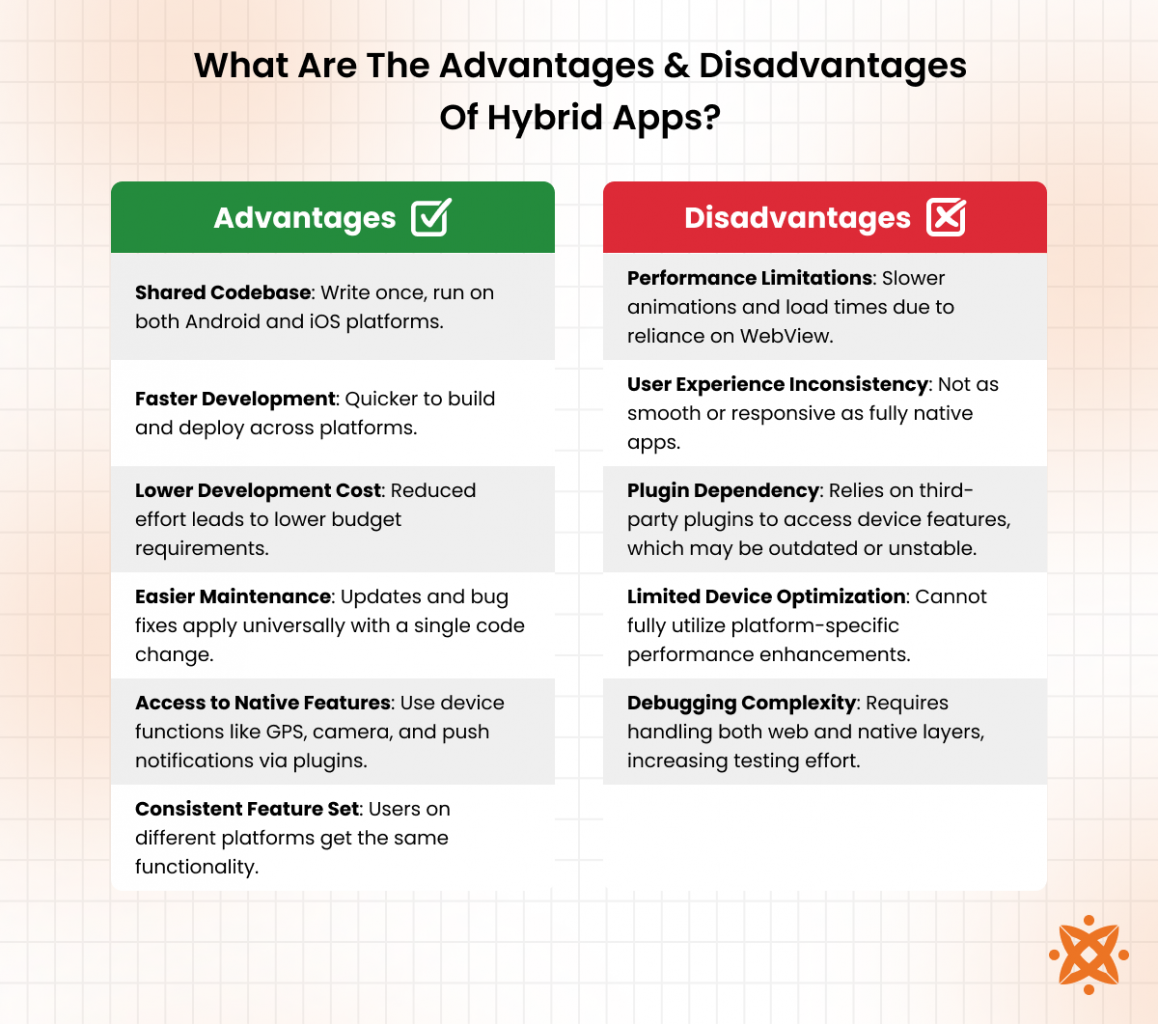
What Are The Best Frameworks And Tools For Hybrid App Development?
The best frameworks and tools for hybrid app development are Ionic, Cordova, Node.js, Django, Laravel, Spring Boot, Meteor, Flutter with Supabase, MEAN Stack, MongoDB, PostgreSQL, Tailwind CSS, Bootstrap, Material UI, Ionic UI Components, and Framework7 UI. These tools support frontend, backend, full-stack development, and user interface design for building responsive hybrid apps.
The best frameworks and tools for hybrid app development are as follows:
Frontend Hybrid App Development Frameworks
The frontend frameworks used in hybrid app development are Ionic, Cordova, Capacitor, Framework7, and Onsen UI. These tools help build user interfaces, manage interactions, and bridge web technologies with native mobile environments.
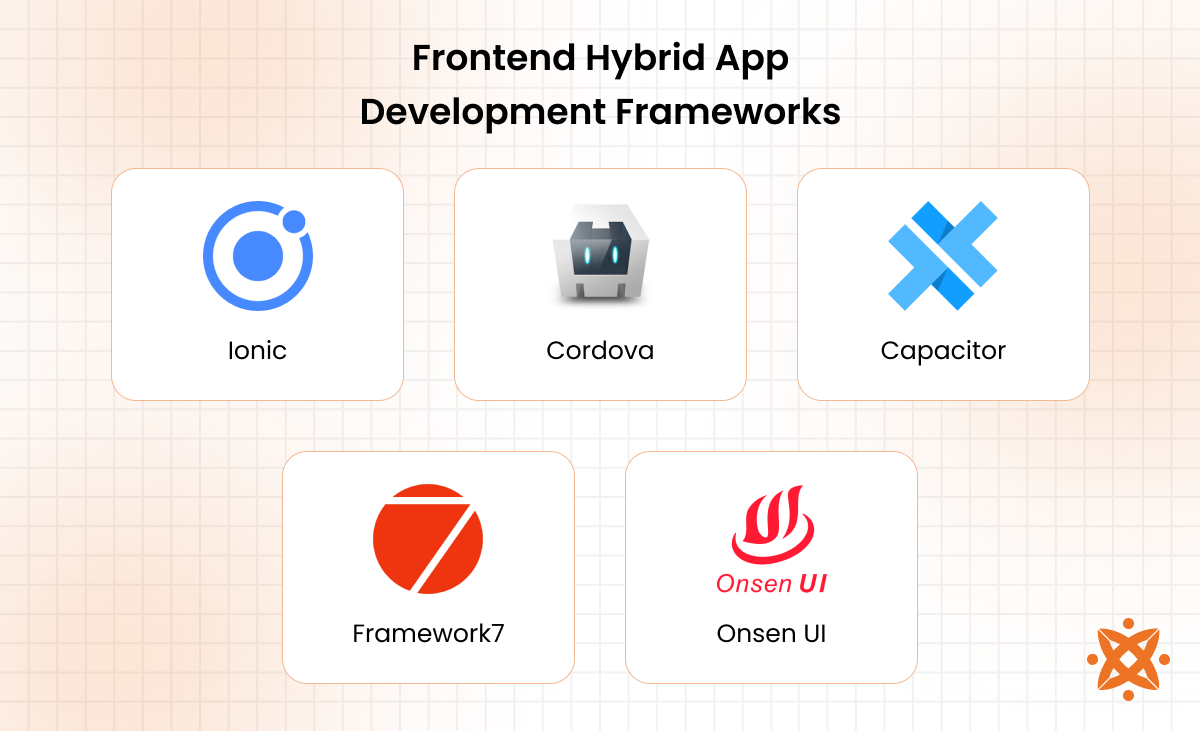
The frontend frameworks used in hybrid app development are:
- Ionic: Ionic is an open-source UI toolkit for building hybrid mobile apps using HTML, CSS, and JavaScript. Launched in 2013 by Max Lynch, Ben Sperry, and Adam Bradley of Drifty Co., it quickly became popular for combining Angular with mobile development. It's easy to use with its component library and CLI, and integrates with tools like Capacitor for native access.
- Cordova: Apache Cordova enables web code to run inside a native container via WebView. Originally developed by Nitobi in 2009 and later acquired by Adobe, it was rebranded as PhoneGap before becoming Apache Cordova. It's straightforward but relies on plugins and basic tools like Node.js and the Cordova CLI for setup.
- Capacitor: Capacitor is a modern replacement for Cordova, developed by the Ionic team to offer better native functionality. Released in 2019, it was designed to integrate smoothly with Ionic and provide consistent plugin support. It requires Node.js, Ionic CLI, and basic web development tools for use.
- Framework7: Framework7 is a free and open-source framework for building iOS and Android apps with a native look and feel. Created by Vladimir Kharlampidi in 2014, it focuses on simplicity and performance with no external dependencies like Angular or React. It's beginner-friendly and only needs basic HTML, CSS, and JS to get started.
- Onsen UI: Onsen UI is a UI framework that uses Web Components and is designed for hybrid mobile development. It was introduced by Monaca (Asial Corporation) and supports Angular, React, and Vue integrations. It's easy to use with the Monaca CLI and comes with a wide set of ready-to-use components.
Backend Hybrid App Development Frameworks
The backend frameworks used in hybrid app development are Node.js, Django, Laravel, Ruby on Rails, and Spring Boot. These frameworks handle server-side logic, data processing, and integration with databases and APIs.
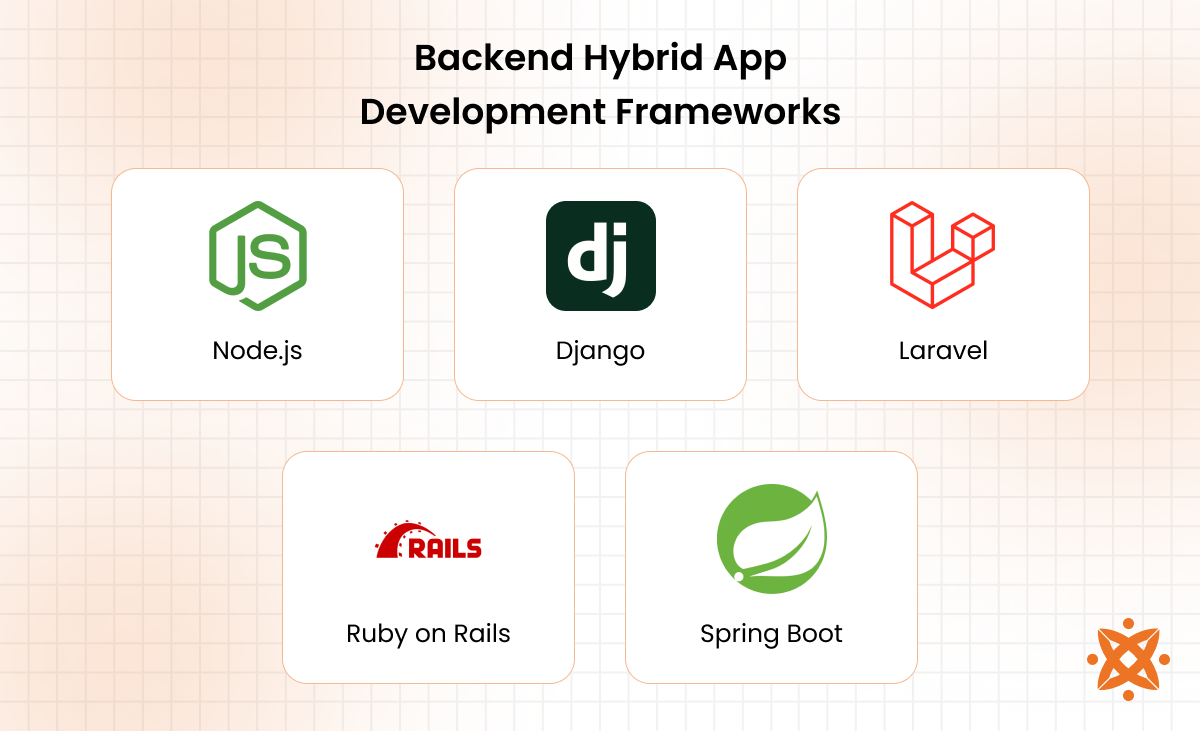
The backend frameworks used in hybrid app development are:
- Node.js: Node.js is a runtime that executes JavaScript code on the server side. Introduced by Ryan Dahl in 2009, it brought asynchronous, event-driven programming to backend development. It's lightweight and fast, using npm and a simple CLI for building scalable server apps.
- Django: Django is a high-level Python web framework designed for clean and rapid development. Created in 2005 by Adrian Holovaty and Simon Willison, it follows the “batteries included” approach. It's beginner-friendly and uses tools like the Django admin panel, ORM, and CLI for efficient backend setup.
- Laravel: Laravel is a PHP framework known for its expressive syntax and developer-friendly environment. It was released by Taylor Otwell in 2011 as an alternative to CodeIgniter. It uses Composer, Artisan CLI, and Blade templating, and is well-suited for apps that require structured MVC design.
- Ruby on Rails: Ruby on Rails, or Rails, is a full-stack web framework built using the Ruby language. It was created by David Heinemeier Hansson in 2004 and introduced the concept of convention over configuration. It's intuitive to use with built-in scaffolding, a strong CLI, and database migration tools.
- Spring Boot: Spring Boot is a Java-based framework that simplifies the setup of production-ready applications. Developed by Pivotal Software and released in 2014, it extends the Spring framework with auto-configuration features. It's suited for complex enterprise applications and uses Maven or Gradle along with Spring CLI.
Full-Stack Hybrid App Development Framework
The full-stack frameworks used in hybrid app development are Meteor, Ionic with Firebase, Flutter with Supabase, MEAN Stack, and MERN Stack. These solutions combine both frontend and backend capabilities, enabling end-to-end development from a unified technology stack.
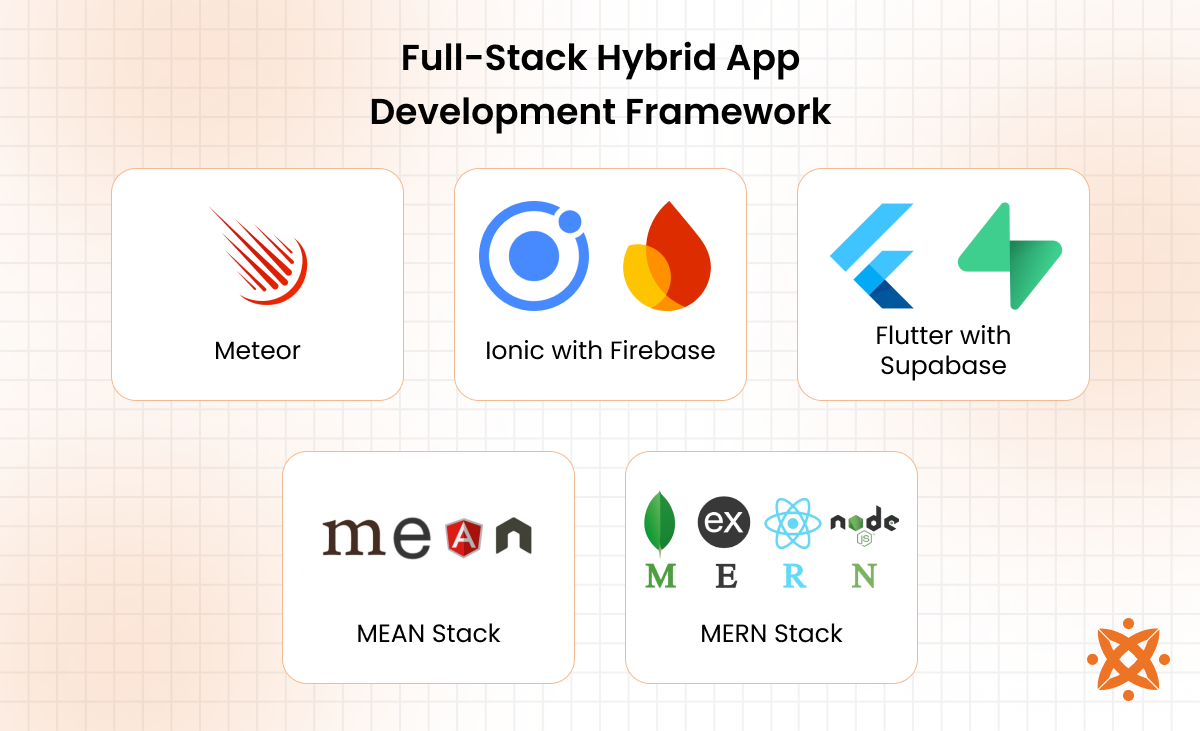
The full-stack frameworks used in hybrid app development are:
- Meteor: Meteor is a full-stack JavaScript framework used for building real-time apps. It was developed by Meteor Development Group in 2012 and gained popularity for its reactive data model. It's simple to use with its built-in CLI and integrates MongoDB, Blaze, or React out of the box.
- Ionic with Firebase: This stack pairs Ionic's UI capabilities with Firebase's backend services, such as authentication, Firestore, and hosting. Firebase was launched by Firebase Inc. in 2011 and acquired by Google in 2014. It's easy to start with via the Firebase CLI, especially for rapid development and prototyping.
- Flutter with Supabase: This combo uses Flutter for the frontend and Supabase as the backend alternative to Firebase. Flutter was created by Google in 2017, and Supabase launched in 2020 as an open-source backend-as-a-service. It's beginner-accessible and requires tools like Flutter CLI, Supabase CLI, and Dart SDK.
- MEAN Stack: MEAN combines MongoDB, Express.js, Angular, and Node.js for JavaScript-powered full-stack development. It emerged in the early 2010s as a response to traditional LAMP stacks. It's relatively straightforward with Node.js tooling, npm, and Angular CLI.
- MERN Stack: MERN replaces Angular with React in the MEAN architecture, offering a component-based frontend model. This variant became widely adopted around 2015 as React's popularity surged. It's easy for JavaScript developers and use tools like Node.js, MongoDB Compass, and React CLI.
Hybrid App Development Databases
The databases commonly used in hybrid app development are Firebase Realtime Database, SQLite, Realm, MongoDB, and PostgreSQL. These options support data storage, syncing, and management across both frontend and backend layers of hybrid applications.
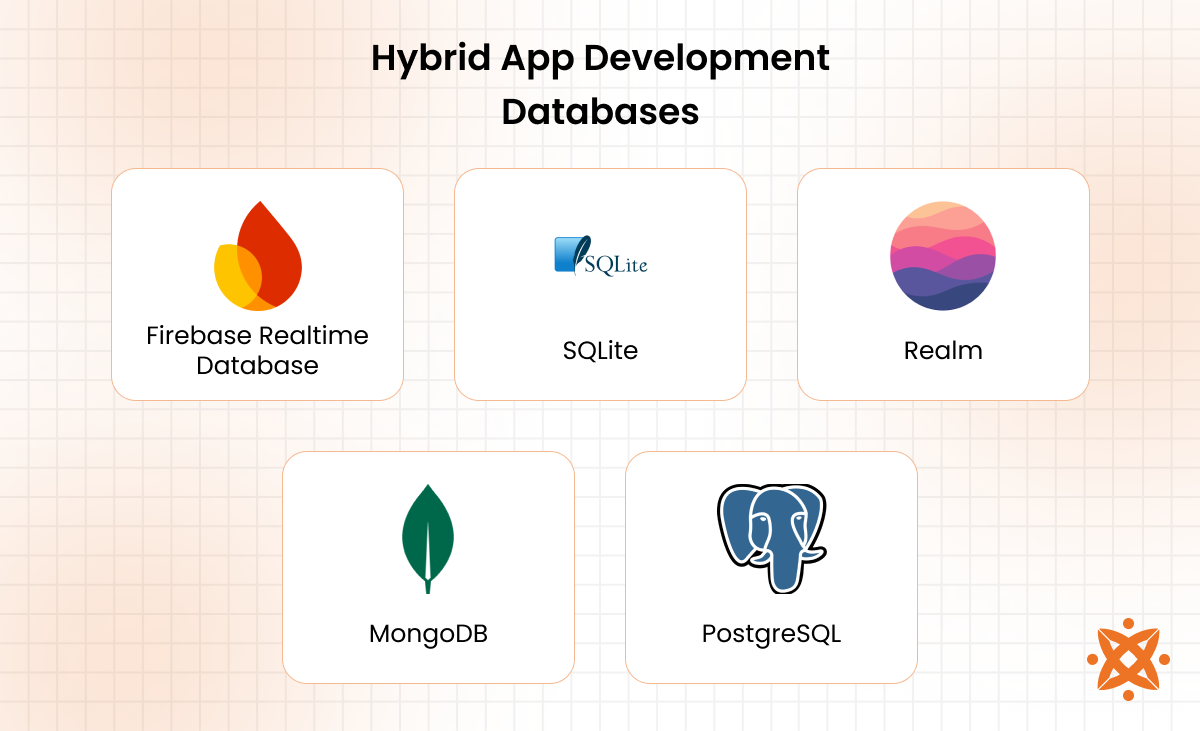
The databases commonly used in hybrid app development are:
- Firebase Realtime Database: Firebase Realtime Database is a cloud-hosted NoSQL database for real-time data sync. It was launched by Firebase Inc. in 2011 and became a part of Google Cloud after its acquisition in 2014. It's beginner-friendly, works with Firebase CLI, and integrates well with hybrid stacks like Ionic and Flutter.
- SQLite: SQLite is a self-contained, file-based SQL database engine embedded directly into applications. It was created by D. Richard Hipp in 2000 and is widely used in mobile app development. It requires no separate server or configuration, making it extremely lightweight and easy to use with native and hybrid apps.
- Realm: Realm is an object-oriented mobile database designed for offline-first functionality. Developed by Realm Inc. in 2014 and acquired by MongoDB in 2019, it supports both iOS and Android platforms. It's easy to use with Realm SDKs and requires minimal setup compared to traditional databases.
- MongoDB: MongoDB is a NoSQL document database that stores data in a flexible, JSON-like format. It was released by MongoDB Inc. (formerly 10gen) in 2009 and is widely adopted in full-stack JavaScript environments. It's simple to use with the MongoDB CLI, Compass GUI, and Mongoose ORM for integration.
- PostgreSQL: PostgreSQL is an open-source relational database system known for robustness and standards compliance. Originating at the University of California in the mid-1980s, it has grown into a widely respected enterprise-grade database. It's accessible via tools like pgAdmin and psql, and works well with most backend frameworks.
Hybrid App Development, CSS Frameworks, And Ui Libraries
The UI libraries and CSS frameworks used in hybrid app development are Tailwind CSS, Bootstrap, Material UI, Ionic UI Components, and Framework7 UI. These tools provide design systems, layout utilities, and reusable components for building polished mobile interfaces.
The UI libraries and CSS frameworks used in hybrid app development are:
- Tailwind CSS: Tailwind CSS is a utility-first CSS framework that allows direct styling within HTML classes. Created by Adam Wathan in 2017, it quickly gained traction for its flexibility and minimalism. It's easy to use with frameworks like Ionic or React and requires Node.js and a build tool like PostCSS.
- Bootstrap: Bootstrap is a responsive design framework that includes prebuilt UI components and grid systems. It was developed by Twitter engineers Mark Otto and Jacob Thornton in 2011. It's beginner-friendly and integrates with HTML, CSS, and JavaScript using just a CDN or npm setup.
- Material UI: Material UI is a React component library based on Google's Material Design system. It launched in 2014 and is maintained by the MUI team to offer design consistency across platforms. It works smoothly with hybrid setups using React and requires Node.js and the MUI package.
- Ionic UI Components: Ionic UI Components are prebuilt, cross-platform components styled for mobile interfaces. They were introduced alongside the Ionic Framework in 2013 by Drifty Co. They are easy to integrate via the Ionic CLI and work natively with Angular, React, or Vue.
- Framework7 UI: Framework7 UI provides native-styled UI elements for iOS and Android using HTML, CSS, and JavaScript. It debuted in 2014 with a focus on replicating native app aesthetics. It's simple to use without external dependencies and is compatible with Vue and React as well.
What Is The Role Of WebView in Hybrid Apps?
The role of WebView in hybrid app development includes rendering web content within a native application shell, enabling interaction between web code and native device functions, and bridging frontend user interfaces with mobile operating systems. WebView acts as a lightweight embedded browser that allows apps to display and interact with HTML, CSS, and JavaScript content directly within the mobile app environment.
This component is vital to hybrid apps because it hosts the UI and business logic while maintaining native access through plugins and APIs. By doing so, it eliminates the need for building separate UI components for each platform. WebView ensures consistency in rendering and enables developers to push updates via web technologies without passing through app store review processes.
What Programming Languages Are Used For Hybrid App Development?
The programming languages used in hybrid app development are HTML, CSS, JavaScript, TypeScript, Python, PHP, Ruby, and Java. They support both frontend and backend functionality across platforms.
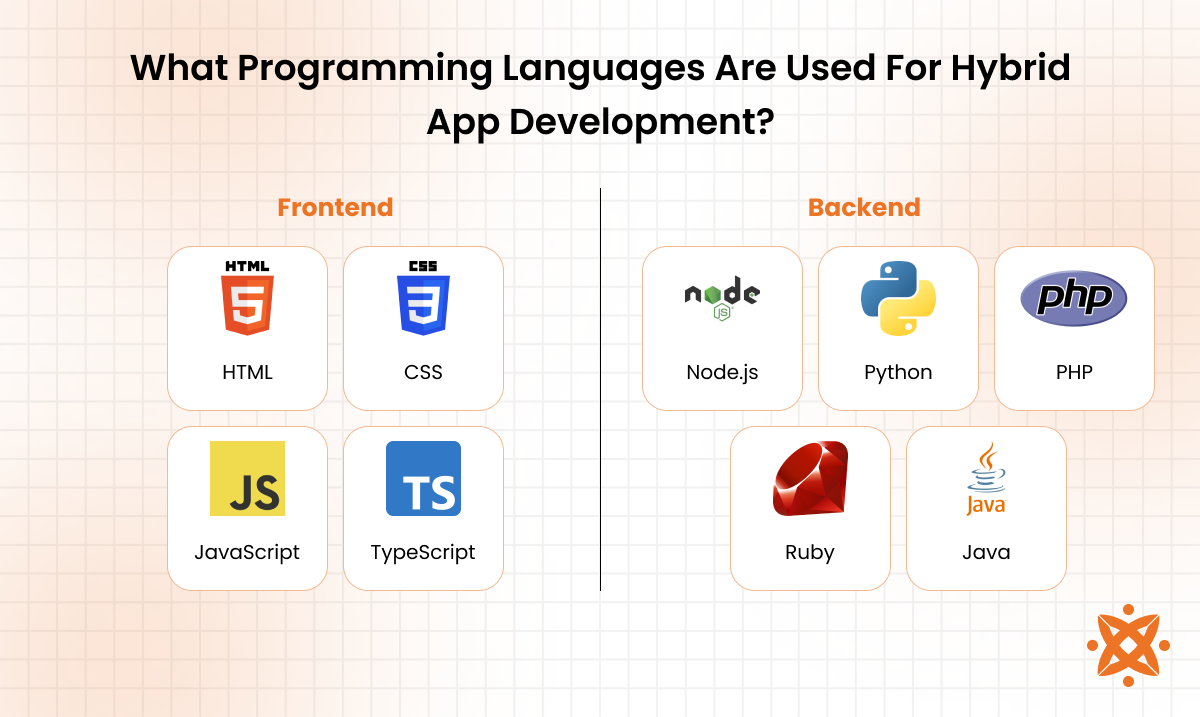
The programming languages used in hybrid app development are as follows:
Frontend Hybrid App Development Programming Languages
The core languages used for the frontend in hybrid app development are HTML, CSS, JavaScript, and TypeScript. These languages shape the structure, design, and interactivity of hybrid mobile applications.
The core languages used for the frontend in hybrid app development are:
- HTML: HTML structures the content and layout of hybrid app interfaces. It supports semantic elements, multimedia embedding, and integration with scripting languages. It's lightweight and widely supported, but requires CSS and JavaScript for styling and interactivity.
- CSS: CSS handles the styling and visual presentation of hybrid apps. Key features include selectors, responsive layouts, animations, and utility frameworks like Tailwind CSS. It's flexible and easy to learn, though layout inconsistencies occur across platforms.
- JavaScript: JavaScript controls interactivity, logic, and dynamic content in hybrid apps. It offers event handling, DOM manipulation, and integration with APIs and frameworks like Ionic and React. It's highly versatile but leads to performance issues if not optimised.
- TypeScript: TypeScript extends JavaScript with static typing, enhancing code quality and maintainability. It includes interfaces, enums, and compile-time error checking, making large projects more manageable. It improves reliability but adds a learning curve and requires compilation.
Backend Hybrid App Development Programming Languages
The backend languages used in hybrid app development are JavaScript (Node.js), Python, PHP, Ruby, and Java. These languages handle server logic, data processing, and communication between the frontend and databases.
The backend languages used in hybrid app development are:
- JavaScript (Node.js): Node.js uses JavaScript for server-side development, enabling a unified language across the stack. It supports non-blocking I/O, event-driven architecture, and a vast npm ecosystem. It's fast and scalable but demands careful management of asynchronous code.
- Python: Python is a general-purpose language known for its readability and simplicity. It features extensive libraries, Django and Flask frameworks, and strong support for APIs. It's beginner-friendly but slower in execution compared to compiled languages.
- PHP: PHP is a server-side scripting language designed for web development. It powers many CMS platforms, supports procedural and object-oriented coding, and integrates with MySQL and Apache. It's easy to deploy but criticised for outdated practices in legacy codebases.
- Ruby: Ruby, when paired with Rails, offers a convention-over-configuration approach for backend development. It promotes rapid development, has a strong developer community, and supports clean syntax. It's elegant but less performant and less commonly used today.
- Java: Java is a statically typed language used for enterprise-grade backend systems. It offers robust tools, the Spring Boot framework, and excellent cross-platform support. It's powerful but requires more setup and verbose syntax compared to dynamic languages.
How To Make A Hybrid App?
To make a hybrid app, the steps are planning the app structure, choosing the right tech stack, setting up the development environment, designing the user interface, developing the frontend and backend, integrating APIs and plugins, testing across platforms, and deploying to app stores. Each step plays a role in ensuring that the app performs well, supports cross-platform compatibility, and meets user expectations.
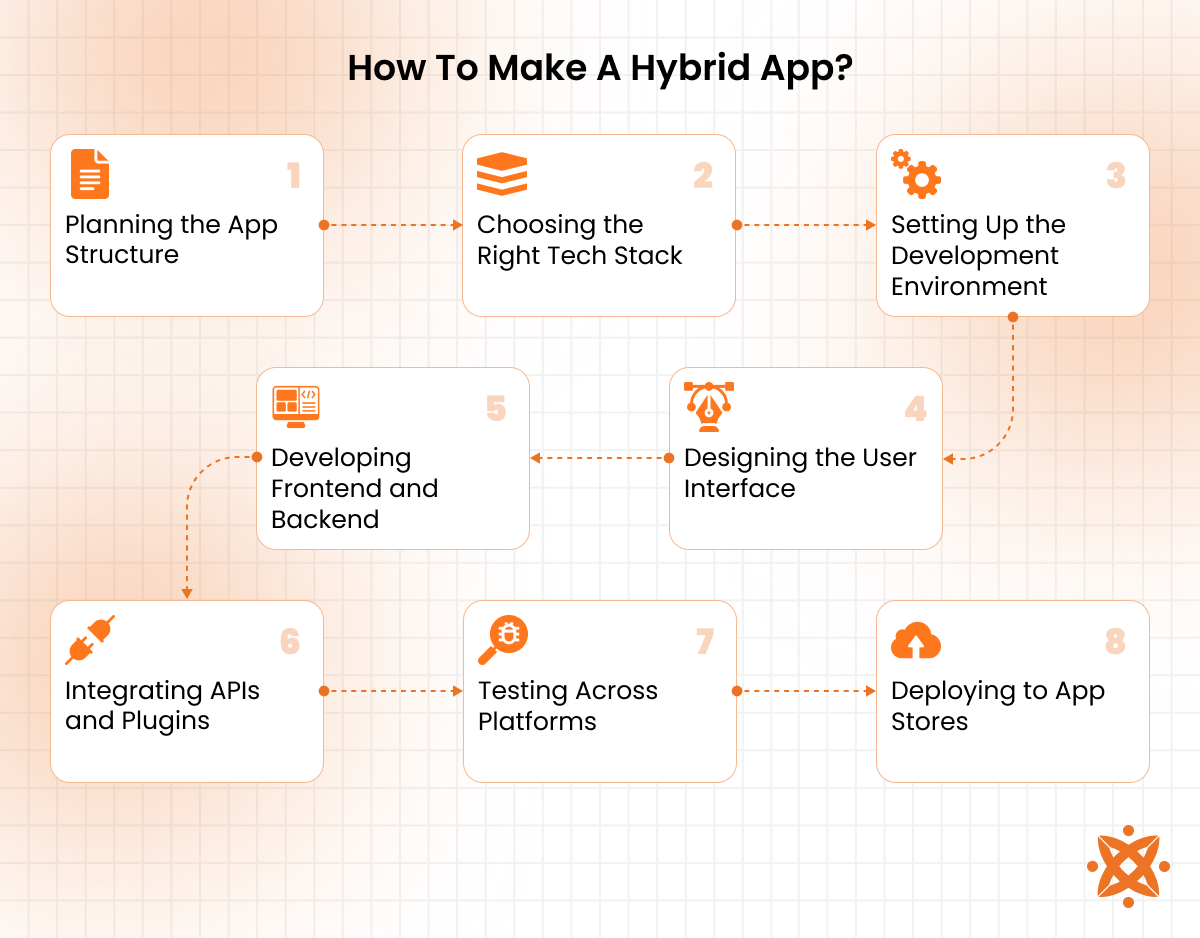
To make a hybrid app, the steps are explained below:
Step 1: Planning the App Structure
Planning the app structure involves defining the app's purpose, core features, target audience, and supported platforms. This step ensures that development stays aligned with business goals and user needs. It includes outlining user journeys, deciding on essential screens, and prioritising functionalities to keep the app lightweight and effective across devices.
During this phase, you should also decide whether the app is content-focused, feature-driven, or data-intensive. Early choices around layout flow, navigation, offline access, and device integrations help determine the right frameworks and plugins later. Documenting this structure also makes collaboration smoother across designers, developers, and stakeholders.
Step 2: Choosing the Right Tech Stack
Choosing the right tech stack means selecting the frontend, backend, frameworks, languages, and tools that match your app's goals and structure. For hybrid development, this includes choosing between Ionic, Flutter, or React Native for the frontend, and picking backend solutions like Node.js, Django, or Firebase based on scalability and performance needs. Your decision impacts app speed, ease of maintenance, and long-term flexibility.
You also need to decide on supporting technologies, such as databases (e.g., MongoDB or PostgreSQL) and UI libraries (e.g., Tailwind CSS or Bootstrap). Compatibility between tools and familiarity within your team should guide your selection. A consistent and well-integrated stack simplifies development, improves performance, and makes updates easier post-launch.
Step 3: Setting Up the Development Environment
Setting up the development environment involves installing the necessary tools and configuring your system to build and test hybrid apps. This usually includes code editors like Visual Studio Code, version control with Git, and CLI tools specific to your chosen framework, such as Ionic CLI, Flutter SDK, or Node.js. You'll also need Android Studio and Xcode to simulate and test apps on Android and iOS, respectively.
Project scaffolding tools help you generate the basic structure quickly, while emulators and device simulators are used to preview performance and layout. It's also vital to set up environment variables, package managers like npm or Yarn, and any backend services, such as Firebase CLI or MongoDB Atlas dashboards. A well-prepared setup ensures efficient development and smooth collaboration across teams.
Step 4: Designing the User Interface
Designing the user interface means crafting a visual layout that's intuitive, accessible, and consistent across platforms. For hybrid apps, the design should accommodate both iOS and Android guidelines while maintaining a unified user experience. Tools like Figma, Sketch, or Adobe XD are used to create wireframes and mockups, helping teams visualise screens before development begins.
Once the design is approved, developers implement it using frameworks like Ionic UI Components, Framework7 UI, or Material UI. These libraries provide prebuilt, responsive elements that replicate native behaviours. Good UI design ensures better usability and reduces the need for major revisions later in the process.
Step 5: Developing Frontend and Backend
Developing the frontend involves coding the user interface using technologies like HTML, CSS, JavaScript, or TypeScript, alongside frameworks such as Ionic, Flutter, or Framework7. This step focuses on rendering screens, managing interactions, and ensuring responsiveness across devices. Developers integrate UI components, handle navigation, and connect to backend APIs to fetch or submit data.
The backend handles data storage, authentication, and business logic. Tools like Node.js, Django, or Laravel are used to build APIs and manage database connections. This part also includes integrating services like Firebase or Supabase and setting up endpoints to support frontend operations securely and efficiently.
Step 6: Integrating APIs and Plugins
Integrating APIs and plugins connects your hybrid app to external services and native device features. This includes adding authentication via OAuth, payment gateways like Stripe, and analytics tools such as Google Analytics. It also involves linking with social media platforms, cloud storage, or mapping services, depending on your app's requirements.
Plugins enable access to device hardware like the camera, GPS, file system, and push notifications. Tools such as Cordova plugins or Capacitor plugins bridge web code with native functions. Proper integration ensures that these features run smoothly across platforms while maintaining app performance and user privacy.
Step 7: Testing Across Platforms
Testing across platforms ensures that your hybrid app behaves consistently on both Android and iOS devices. It involves functional testing, UI checks, performance analysis, and compatibility reviews using emulators and real devices. Tools like Appium, BrowserStack, and Ionic DevApp help smooth this process.
Manual and automated testing should cover screen transitions, form inputs, plugin responses, and device-specific behaviour. Debugging tools integrated into IDEs and browser consoles assist in identifying errors. Thorough testing prevents post-launch issues and improves app reliability across the device spectrum.
Step 8: Deploying to App Stores
Deploying to app stores involves packaging your hybrid app for Android and iOS and submitting it to Google Play and the Apple App Store. This includes generating signed APKs or AABs for Android using Android Studio, and creating an IPA for iOS using Xcode and Apple Developer tools. Each platform requires unique assets like app icons, splash screens, and store descriptions.
Before submission, your app must pass validation checks, meet platform guidelines, and include metadata such as versioning and permissions. Once approved, updates are managed centrally if the code is unified. Proper deployment ensures your app is publicly available and discoverable through major app distribution channels.
How Long Does It Take To Develop A Hybrid App?
It takes 8 to 16 weeks to develop a standard hybrid app from planning to deployment. Simple apps with basic features and minimal integrations are completed in 6 to 8 weeks, while mid-level apps with user authentication, APIs, and moderate UI complexity require 10 to 12 weeks.
Complex apps involving real-time data, offline functionality, and custom plugins take up to 16 weeks or more, especially when extensive testing and platform-specific adjustments are included.
What Is The Difference Between Hybrid App And Web App?
The main difference between a hybrid app and a web app is that a hybrid app is installed on a device and runs inside a native container, while a web app is accessed through a mobile browser and does not require installation. Hybrid apps function offline, access device hardware, and are published to app stores, whereas web apps depend entirely on internet access and browser capabilities.
A web app is developed using standard web technologies and lacks direct access to device features unless enhanced by progressive web techniques. Hybrid apps, in contrast, use WebView and native plugins to deliver a more integrated mobile experience. While both share similar codebases, only hybrid apps provide a bridge between native device performance and web-based development.
What Is The Difference Between Hybrid App And Native App?
The main difference between a hybrid app and a native app is that a hybrid app uses a single codebase across platforms, while a native app is built separately for each operating system using platform-specific languages and tools. Hybrid apps are quicker to develop and maintain, whereas native apps offer maximum performance and deep integration with device hardware.
A native app is written in Swift or Objective-C for iOS and Kotlin or Java for Android, giving it direct access to system APIs and better responsiveness. Hybrid apps, by contrast, use WebView and plugins to approximate this functionality. While native apps provide a smoother experience for high-performance tasks like gaming or AR, hybrid apps are more efficient for general-purpose applications that prioritise cross-platform reach.
What Is The Difference Between Hybrid App And Progressive Web App?
The main difference between a hybrid app and a progressive web app is that a hybrid app is distributed through app stores and installed on devices, while a progressive web app is accessed through a web browser and behaves like a native app using modern browser APIs. Hybrid apps use a native container to run web content, whereas PWAs rely entirely on the browser environment.
A progressive web app uses service workers, manifests, and caching to deliver offline access and app-like experiences directly from the web. Hybrid apps, on the other hand, use tools like Cordova or Capacitor to interact with native hardware. While both support cross-platform functionality, hybrid apps offer broader hardware access, whereas PWAs are lighter and quicker to deploy without store approval.
What Is The Difference Between Hybrid App And Cross-Platform App?
The main difference between a hybrid app and a cross-platform app is that a hybrid app uses web technologies inside a native shell, while a cross-platform app is built using native APIs compiled for multiple platforms using a shared codebase. Hybrid apps run through a WebView, whereas cross-platform apps produce native UI components through frameworks.
A cross-platform app is developed with tools like Flutter, React Native, or Xamarin, which generate near-native performance without relying on WebView. Hybrid apps, in contrast, prioritise code reusability with broader compatibility at the cost of reduced speed and UI fidelity. While both approaches aim to unify development for Android and iOS, cross-platform apps are preferred for performance-sensitive applications.
How To Choose The Right Hybrid App Development Company?
To choose the right hybrid app development company, the factors involved are evaluating technical expertise, past performance, communication practices, pricing, and long-term support. A reliable agency aligns with your business needs and offers scalable solutions that work across platforms.
To choose the right hybrid app development company, the factors involved are: Experience with hybrid frameworks: Choose an agency with hands-on expertise in Ionic, Flutter, or React Native. Their familiarity with these tools ensures smooth cross-platform development and efficient code reuse. Ask for live demos or repositories to verify technical depth.
Transparent development process: A clear workflow from planning to testing shows the company’s commitment to structure and accountability. Agencies should share timelines, tools used, and feedback intervals. This builds trust and keeps your project aligned with expectations.
Cross-platform testing capabilities: Hybrid apps must perform well on Android and iOS, across devices and screen sizes. The right agency should test in emulators, real devices, and under different network conditions. This reduces post-launch issues and improves user satisfaction.
Post-launch support and updates: Support doesn’t stop at deployment; updates and maintenance are vital for long-term success. Look for an agency that offers version upgrades, plugin updates, and ongoing optimisation. A responsive support team ensures your app remains reliable.
Client testimonials and case studies: Past work reflects how an agency handles real-world challenges. Review case studies with clear metrics and client feedback on collaboration and results. Genuine success stories speak louder than promises.
If you’re searching for a trusted app development company, consider Intelivita for your hybrid app needs. They bring extensive experience with cross-platform technologies, a transparent development model, and a proven track record of delivering high-quality mobile solutions. Their collaborative approach ensures your app is functional, scalable, and market-ready.
How Much Does It Cost To Develop A Hybrid App?
It costs an average of £20,000 to £60,000 to develop a hybrid app, depending on its complexity, feature set, and platform requirements. Basic apps with limited screens and simple functionality fall at the lower end, while apps requiring integrations, real-time data, or custom plugins move toward the higher range.
Factors influencing cost include UI design depth, third-party API usage, backend infrastructure, developer location, and testing scope. Budgeting should also account for post-launch updates, maintenance, and potential scalability enhancements.
What Are The Best Practices For Hybrid App Development?
The best practices for hybrid app development include choosing the right framework, optimising performance, using native plugins wisely, designing responsive UIs, testing across platforms, and planning for scalability. Following these principles helps create reliable, user-friendly apps that perform consistently across devices and operating systems.
The best practices for hybrid app development are:
- Choosing the right framework: Select a framework that suits your app's complexity and your team's expertise. Tools like Ionic and Flutter support rich UIs and native functionality. The right choice impacts speed, compatibility, and development efficiency.
- Optimising performance: Minimise the use of heavy animations and unnecessary scripts. Use lazy loading, caching, and efficient API calls to enhance load times. A responsive and fast app improves user engagement and retention.
- Using native plugins wisely: Plugins bridge web code with device features, but overuse affects performance. Rely on trusted and well-maintained plugins only. Keep plugin usage documented and updated to prevent compatibility issues.
- Designing responsive UIs: Your app must adapt to various screen sizes and resolutions. Use flexible layouts and scalable elements to maintain usability across devices. Responsive design ensures a consistent experience on both tablets and smartphones.
- Testing across platforms: Conduct manual and automated tests on Android and iOS using real devices and emulators. Cover UI behaviour, network responses, and hardware integration. This ensures your app behaves as expected for all users.
- Planning for scalability: Design your backend and architecture to handle future growth. Use cloud databases, modular code, and version control to support updates. A scalable app is easier to maintain and expand over time.
What Are The Trends In Hybrid App Development?
The top trends in hybrid app development include increased use of Flutter, progressive enhancements, offline-first functionality, integration of AI services, cloud backend adoption, and focus on performance optimisation. These trends are shaping how developers build modern cross-platform applications for speed, accessibility, and user satisfaction.
The top trends in hybrid app development are:
- Increased use of Flutter: Flutter's growing adoption in hybrid development is driven by its native-like performance and single codebase efficiency. Its support for both Android and iOS, plus integration with web and desktop, makes it versatile. Google's continued investment ensures stability and long-term viability.
- Progressive enhancements: Developers are layering native capabilities over core web functionality to create better user experiences. This includes using service workers, background sync, and push notifications in hybrid apps. These additions make apps more interactive and platform-aware.
- Offline-first functionality: Hybrid apps are now built with offline usability in mind. Tools like Realm or IndexedDB help store data locally and sync it when connectivity returns. This trend improves user retention and app usability in low-connectivity environments.
- Integration of AI services: Hybrid apps increasingly connect with third-party AI services for features like chatbots, recommendations, and automation. APIs from Google Cloud, Microsoft Azure, or OpenAI are common integrations. This adds smart functionality without increasing frontend complexity.
- Cloud backend adoption: More developers are shifting backend infrastructure to platforms like Firebase, Supabase, and AWS Amplify. These services simplify data management, authentication, and scaling. It reduces backend maintenance and accelerates deployment.
- Focus on performance optimisation: Developers now prioritise app speed, responsiveness, and resource efficiency. Techniques like code splitting, lazy loading, and hardware-accelerated animations are being used. These improvements are vital to compete with native app standards.
Should Startups Choose Hybrid App Development?
Yes, startups should choose hybrid app development if they need a faster launch, cross-platform reach, and have limited development resources. It's ideal for MVPs, budget-sensitive projects, and apps with standard features that don't require deep native functionality.
But they should not if their app requires intensive graphics, low-latency performance, or complex native integrations such as AR/VR or heavy animations. In such cases, native development provides better control and a smoother user experience.
Can Hybrid Apps Be Deployed To Google Play And App Store?
Yes, hybrid apps can be deployed to Google Play and the App Store if they are properly built using native containers and comply with platform-specific guidelines. Tools like Ionic, Capacitor, and Flutter allow developers to compile hybrid code into installable native packages. As long as the app delivers functional value, native integration, and passes review standards, it is published like any native app.
Can You Convert A Website Into A Hybrid App?
Yes, you can convert a website into a hybrid app by wrapping its web content using frameworks like Cordova, Capacitor, or Framework7. This process involves embedding the existing site into a WebView and enhancing it with plugins to access device features. With proper UI adjustments and mobile optimisation, the converted app is published to app stores and behaves like a native application.
Do Hybrid Apps Work Offline?
Yes, hybrid apps work offline when designed with local storage, caching, and offline-first strategies. Using technologies like IndexedDB, SQLite, or service workers, developers store data and allow the app to function without network access. This capability enhances usability in low-connectivity environments and improves user experience.
Never Miss an Update From Us!
Sign up now and get notified when we publish a new article!
Dhaval Sarvaiya
Co-Founder
Hey there. I am Dhaval Sarvaiya, one of the Founders of Intelivita. Intelivita is a mobile app development company that helps companies achieve the goal of Digital Transformation. I help Enterprises and Startups overcome their Digital Transformation and mobile app development challenges with the might of on-demand solutions powered by cutting-edge technology.
